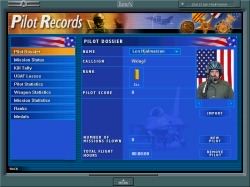|
Campaign AI and Immersion
by Leonard "Viking1" Hjalmarson |
||||
|
Looking back now, I think the element Andy neglected was the "feel" of the environment itself, though he might have intended to include that feeling in his reference to the "larger world." There is little question in my mind that Andy understood these things intuitively, even if in this case he didn't quite put it into words.
 USAF Pilot Records I would argue that that feel of a dynamic environment is paramount in creating believability and even raw "fun." And the dynamism of that environment extends to both simulation and interface. What I mean by the dynamism extending to the interface is the flow between missions and the form and frequency of supply of intelligence (debriefing, mission assessment, pilot records, mission planning elements etc.) And here is where Pixel Multimedia and JANE's have come close to solid gold with USAF, and where Rowan and Empire have come close to solid gold with MiG Alley. USAF has an AWACS like interface which helps provide a sense of dynamism, and the strength of the graphics engine contributes greatly to an immersive environment. The detail of pilot records helps greatly to the sense that missions really matter. MiG Alley, on the other hand, in its fifth campaign allows a degree of player interaction that surpasses even Falcon 4.0. The amount of information available on a particular target and the ability of the user to determine both strategic and tactical dimensions contribute greatly to immersion via the sense of responsibility for the overall campaign. |
I have used this term "immersion" a number of times now. How do I define it? Immersion occurs when a game looks more and responds more like the real world, does a better job at helping me care about my alter ego and what happens to my platoon/squad etc, connects events in a logical and believable manner, is less predictable (while remaining true to reasonable strategic and tactical considerations), has an interface which is unobtrusive and fluid, and also supplies important tactical and strategic information relatively transparently, then it is more or less immersive. In the end, it seems that "immersion" is a very broad topic, and each of us will find that different approaches enhance our own experience. The success of USAF is due in large part to a dynamic balancing of a number of factors that are important to a very broad cross section of the sim community. MiG Alleys appeal is quite different, but in the end may prove almost as broad via an entirely different set of "spokes." An Art and a Science The problem is that simply assembling the correct spokes to a solid hub may not in itself make for the perfect simulation. What I am getting at here is that there is a "gestalt" to good simulation design that makes it more of an art than a science. In fact, art and science must come together to make a really good simulation product, because "the whole is greater than the sum of the parts." But whatever the reasons that a particular military simulation appeals to you, most will agree that it must immerse the virtual pilot in a believable world. If it can do that without demanding that one read a four hundred page manual and spend fifteen hours flying each and every week, it will increase the economic viability of the developer. In the end, that is a very important goal! Join a discussion forum on this article by clicking HERE.
|
|||
|
Copyright © 1997 - 2000 COMBATSIM.COM, INC. All Rights Reserved. Last Updated November 15th, 1999 |
||||
